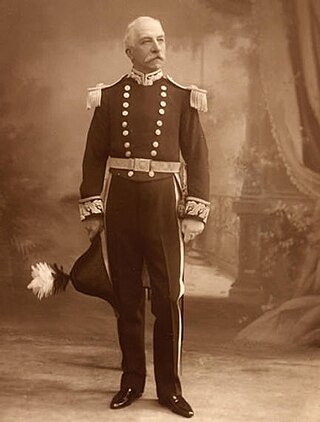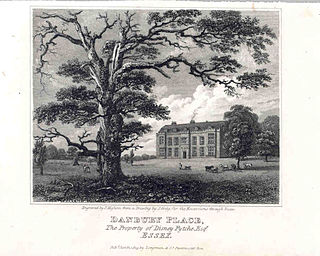
Aston Hall is a former English country house in the village of Aston, South Yorkshire. It is now a hotel, and a Grade II* listed building.

Aston Hall is a former English country house in the village of Aston, South Yorkshire. It is now a hotel, and a Grade II* listed building.
Aston Hall was a large country house, in the civil parish of Aston cum Aughton.
The original manor house was home to the Darcys, descendants of George Darcy, 1st Baron of Aston. He married Dorothy Melton, whose ancestors were the earlier lords of the manor.
Following a fire, Robert Darcy, 4th Earl of Holderness had the remains of the old Darcy house pulled down. [1] It was rebuilt in 1771–72 by York architect John Carr. [2] Holderness let it to Harry Verelst, and sold it to him in 1774–75. [1] A marble staircase was added in 1776–77 by John Platt, for Verelst. [1] [3]

The Verelst family owned the Hall and most of the original Aston estate for around 150 years. The house and grounds were eventually broken up at a sale in the 1920s. [1] [4]
Harry Verelst had been Governor of Bengal from 1767 to 1769, and returned to England in 1770, marrying in 1771 Ann Wordsworth, with whom he had ten children. He spent heavily on acquiring from Holderness the Aston estate, as well as the house, causing him later financial problems when his assets in Bengal could not be repatriated. He died in 1785 in Boulogne, evading creditors. William Verelst (1784–1851), born at Aston Hall and the youngest of four sons, an academic and cleric, was last in the Verelst direct male line. [5] [6]
James Webster-Wedderburn rented the house. It is described as having a library and billiard room, many bedrooms, and ample stables. It was the setting of a celebrated house party in 1813, with its flirtation between his wife, Frances Webster, and Lord Byron. [7] A wing for domestic service was added in 1825. [1]
The Hall passed to Charles Reed, who changed his surname to Verelst. [8] He was the illegitimate son of Arthur Charles Verelst (1779–1843), the third son of Harry Verelst and a cleric, who inherited Aston Hall in 1837. [9] [10] [11] Charles' eldest son, Harry Verelst, an amateur first class cricketer, died at the Hall in April 1918. His eldest son, Harry Wilson Verelst, had been killed aged 26 at the Battle of the Somme in 1916 and the estate was inherited by Harry Verelst's only surviving son, Rodney Wilson Verelst, before being broken up and sold in 1928. [12] [13]
At one period, the house was known as Aughton Court, referring to the building with later additions on the site, [1] around 1872. [14] It then served as Aughton Hospital. [2] It was bought by West Riding County Council in 1948 to be used as a hospital for female patients with intellectual disability, called Aston Hall Institution and then Aughton Court Hospital. [14] The hospital building programme in 1966 called it an "inadequate unit", and foresaw expansion at nearby Middlewood Hospital. [15] In 1968 it was undergoing conversion into a nursing home. [1] The hospital was closed in 1984. [14]

James Edmeston was an English architect and surveyor; he was also known as a prolific writer of church hymns.

George Tattersall was an English sporting artist and architect.
Thomas Cartwright was a 17th-century English stonemason, building contractor and sculptor.
Sir Conyers Darcy or Darcey,, of Aske, near Richmond, Yorkshire, was a British Army officer, courtier and Whig politician who sat in the House of Commons between 1707 and 1758.
John Plowman (c.1773–1843) was an English architect based in Oxford. His younger son John Plowman (1807–1871) also worked on buildings on Oxford, leading to issues with attribution.

Hornby Castle is a grade I listed fortified manor house on the edge of Wensleydale between Bedale and Leyburn, in the county of North Yorkshire, England.

Harry William Verelst was an English amateur first-class cricketer, who played three games for Yorkshire County Cricket Club in 1868 and 1869. He also appeared in first-class games for the Marylebone Cricket Club (MCC) (1868), Gentlemen of the North (1867), North of the Thames (1868), Gentlemen of England (1870) and I Zingari (1878).

Aston is a residential village in the Metropolitan Borough of Rotherham, South Yorkshire, England. The village falls within the Holderness ward of the borough. Aston is approximately 2 miles (3 km) from Rother Valley Country Park.

Edward Wortley Montagu was an English coal-owner and politician. He was British Ambassador to the Ottoman Empire, husband of the writer Lady Mary Wortley Montagu and father of the writer and traveller Edward Wortley Montagu.

Swallownest is a village in the civil parish of Aston cum Aughton and the Metropolitan Borough of Rotherham, South Yorkshire, England. The village is 4 miles (6.4 km) south of Rotherham and 7 miles (11 km) from Sheffield.
Thomas Johnson (c.1762–1814) was a British architect who designed the 1808 building for the Leeds Library in Leeds, West Yorkshire, England. He built William Hey's house at 1, Albion Place, Leeds, and Holy Trinity Church, Halifax. It is possible that he also worked on the redesign of the south west section of Temple Newsam House, near Leeds.
Charles Reed was an English architect. He practised in Birkenhead, which was then in Cheshire and later in Merseyside.
William Oram was an English painter and architect.

Danbury Place was an English country house, first built by Walter Mildmay in the time of Elizabeth I, dated to 1589. It is situated on one of the highest points of the county of Essex.

Robert Dingley was an English merchant and banker, known as a philanthropist. He was elected a Fellow of the Royal Society (FRS) in 1747.

Charles John Carter was an architect and surveyor working in Louth, Lincolnshire. Sir Howard Colvin suggests that he may have come to Louth from Brereton in Staffordshire around 1832. Most of the work that he undertook was the building or restoration of churches and designing rectories and vicarages. He also appears to have been closely connected with the laying out and construction of houses at Cleethorpes, following the Enclosure Act in 1842. This was a period of rapid development at Cleethorpes, as it developed into a popular sea bathing resort. He had a house in Upgate, Louth and also an office in Westgate, Louth. He was a great collector of antiquities and had an extensive architectural library and collection of drawings. Following his death an auction sale was held of his possessions, which lasted for four days. Following his death, he may have been succeeded in his Louth practice by Maughan and Fowler.

Sir Thomas Parkyns, 2nd Baronet was an English writer, landowner, architect and engineer who was a prominent figure in British wrestling during the Georgian era.

The Stapleton baronetcy, of Carlton, Yorkshire, was created on 20 March 1661/2 Old Style for Miles Stapleton (1626–1707), the son of Gilbert Stapleton of Carlton.
Sir David Hunter-Blair, 3rd Baronet (1778–1857) was a Scottish plantation owner in Jamaica. He also held the office of King's Printer in Scotland.
Aston cum Aughton is a civil parish in the Metropolitan Borough of Rotherham, South Yorkshire, England. The parish contains 25 listed buildings that are recorded in the National Heritage List for England. Of these, one is listed at Grade I, the highest of the three grades, one is at Grade II*, the middle grade, and the others are at Grade II, the lowest grade. The parish contains the villages of Aston, Aughton and Swallownest and the surrounding countryside. Most of the listed buildings are houses and associated structures, farmhouses and farm buildings. The other listed buildings include a church, associated gate piers and a gravestone, a former school used as a reading room, and two mileposts.